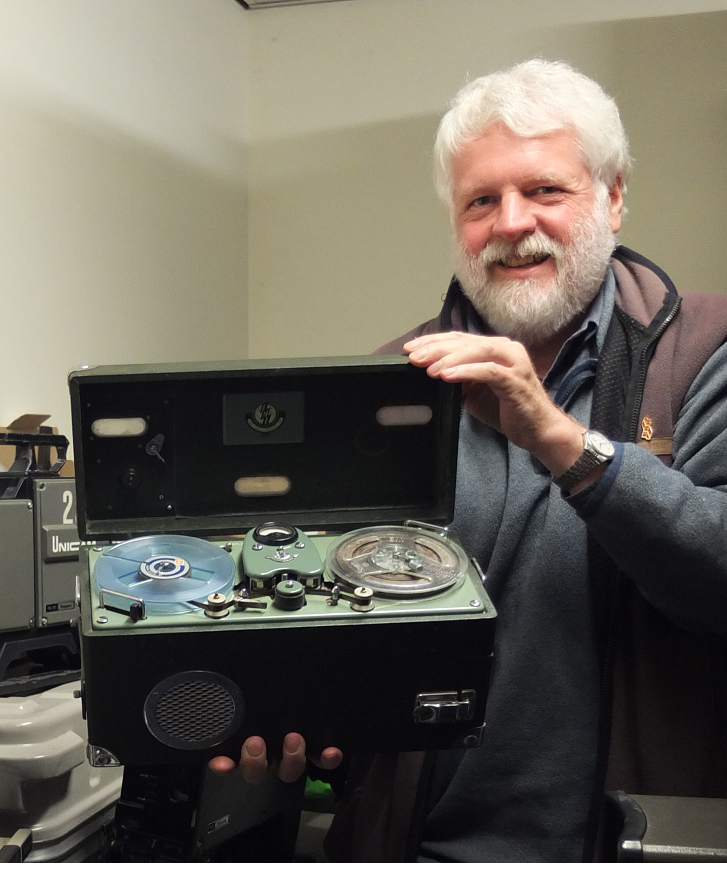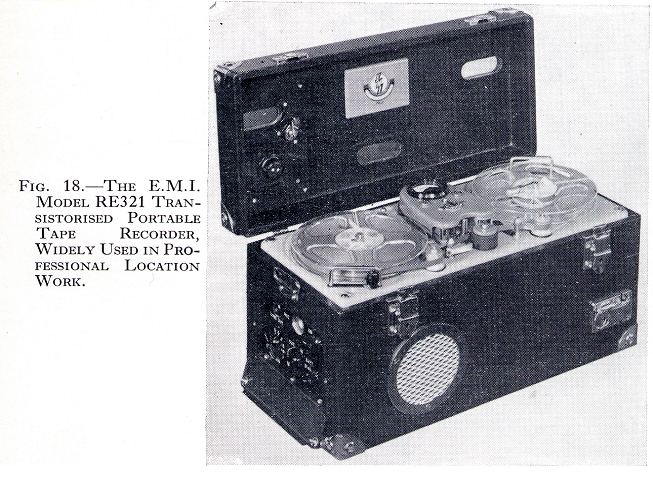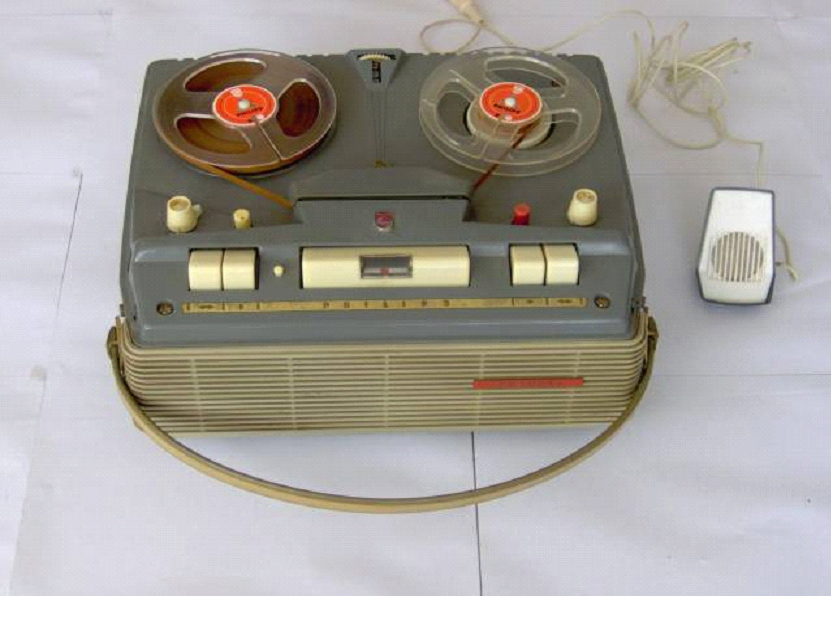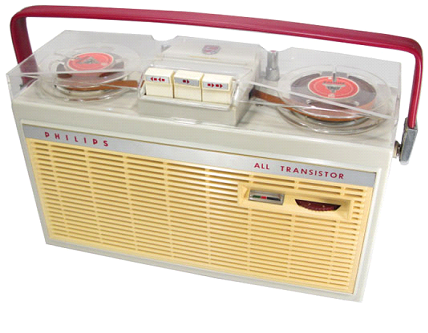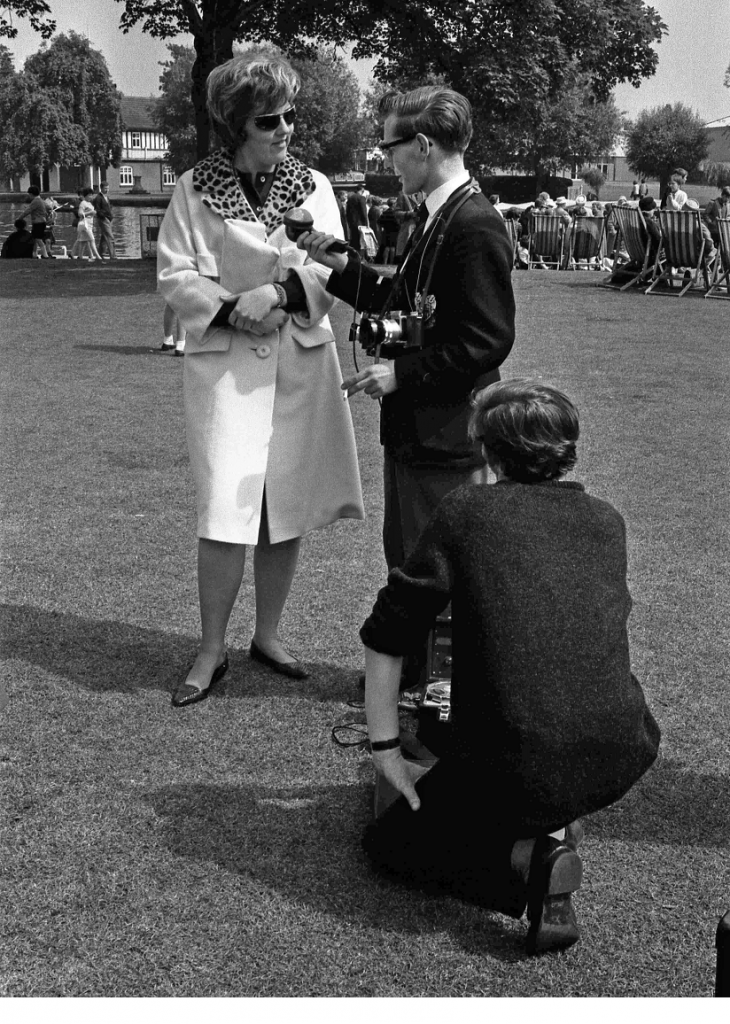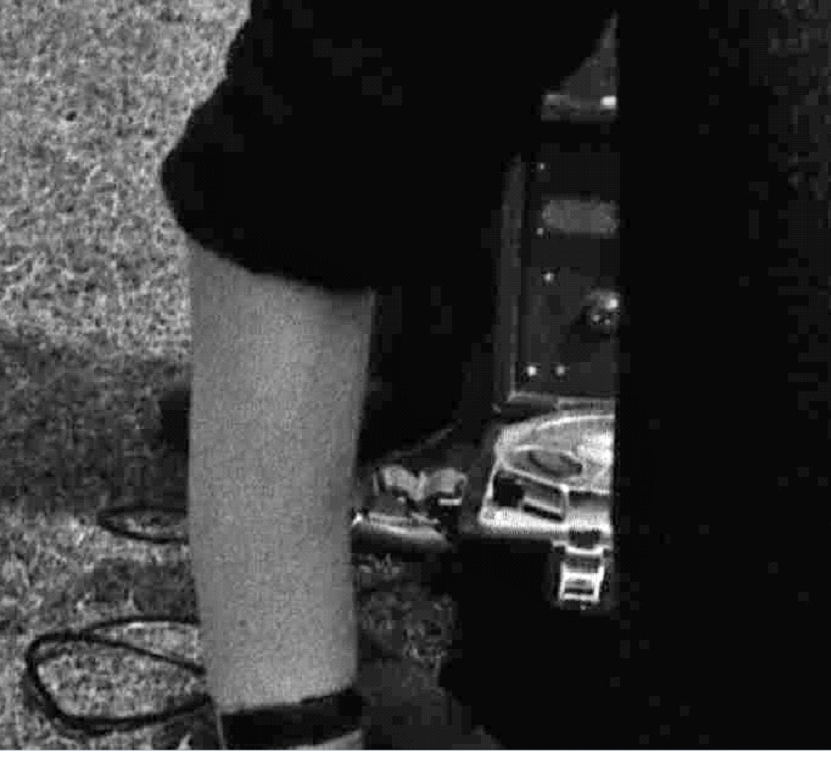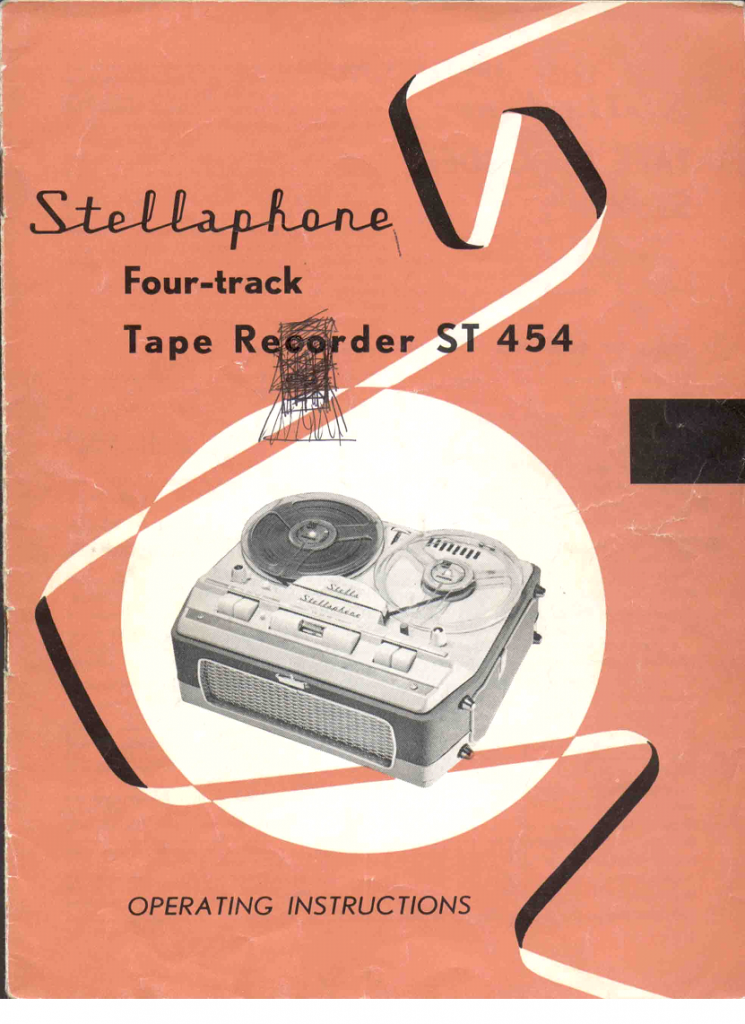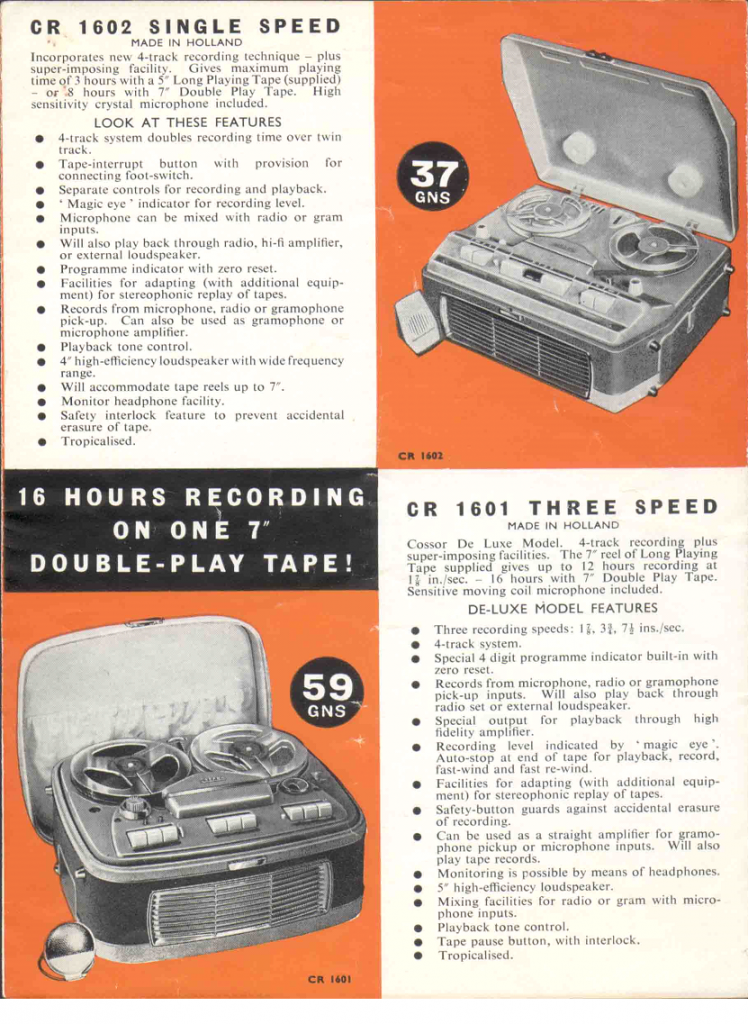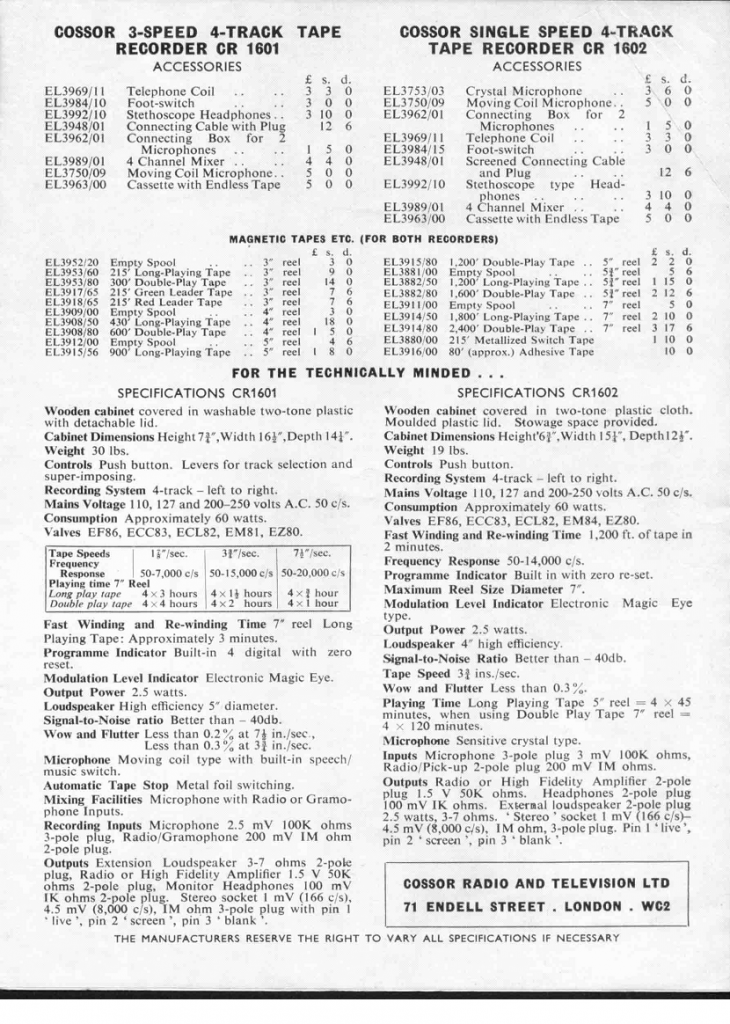Pat Heigham
This was a request from one of our film colleagues in AMPS.
“… I have a friend involved in a stage production called “All of Nothing – the story of the Small Faces”. He has asked if I can help them source a 1960s tape recorder, the type used by reporters of the time. Initially, he asked for details of what would have been used by TV news crews i.e. camera plus amplifier. However, it seems they just need the small audio recorder… “
Can anyone who came from Ealing Film Unit suggest a recorder that might have been
in use during the early sixties (EMI L2, Perfectone?)
I’ve listed a Fi-Cord for non-sync use, as TVC had one I borrowed once.
I used a couple of Auricon s-o-f cameras for “Sportsview”s boxing matches.
Dave Plowman
I had a schoolmate who transferred from radio to Ealing in the 1960s, and I do remember him talking about Perfectone. Don’t remember him mentioning the EMI.
John Howell
I would suggest the transistorised EMI L2, model RE321: it is featured in “Magnetic Tape Recording Handbook” by R E B Hickman, pub. Newnes 1962.
The Ficord seems a possibility although running at 7.5 ips a 3 1/4 Inch reel of long-play tape would only last 10 Minutes (I think!). It’s too early for the Nagra SN, besides this would be over the top in terms of cost and performance for News Reporting.
If a typical microphone is required I would suggest ST &C Apple & Biscuit (4021), 4037 stick mic, or 4032c this latter had a Pressel switch for running the tape recorder.
Albert Barber
I think Peter Bartlet used a Nagra with an Eclaire on “Inside America”. The L2 was, by then, a bit long in the tooth. It depends on whether the camera was there.
Roger Long
BBC radio types had Uhers.
TV on film used Perfectone MK1 and MKIIs and Nagra IIIs when operated by a recordist.
There were Fi Cord 1as and other miniature recorders in use for radio reporters.
Uher was the poor man’s Nagra,: the L2 was much earlier, in the 1950s, no erase, hand rewind, playback through the mic !
For the Small Faces era it might even have been a Phillips Cassette machine, however a Uher Reporter would make sense.
Dave Buckley
I don’t know when the play is set, but the cassette didn’t come in until 1963.
Roger Long
The Small Faces were founded in 1965. So it could have been cassette but the Uher Reporter is more likely.
Dave Mundy
The L2 was definitely in use by Midland region radio news reporters. In Broad Street Studio Centre there was a small maintenance workshop full of L2 recorders. I also remember Fi-Cords being used as well, this was 1960-1963 when I worked there.
Tony Crake
Is this the L2 ?
(Click on the picture below to see larger version:
use your Browser’s BACK button to return to this page)
Dave Buckley
In answer to Tony Crake – yes it is an L2! (EMI L2 Midget recorder)
I owned both versions at one time. The original valve version I bought off someone at AP in the mid-1960s and it came with a spare set of valves and the handbook. I used it a lot for hospital radio work, and, in 1965, I went to a traction engine rally at Woburn Abbey to record sound effects for a film the film club I then belonged to were producing. A few years ago, the club wanted the sound track ‘revived’ so I copied the tape to my editing computer and remade the complete sound track to a video copy of the film.
I obtained the transistor version in the early 1970s. This had a stereo head so that sync pulses from a camera could be recorded on the bottom track, some years later and used it for another amateur film.
Subsequently, I sent both machines to Radio Training at the Langham for their museum. I’m not sure if radio training still exists in its original form, so I don’t know what has happened to the museum there.
Overall, I wish I had kept both machines. There was also an L4.
John Howell
Well, it can’t be an L2, he is taking all the weight on one hand! (joking).
I think it’s the transistor version RE321 (picture below) as I don’t recall a monitor speaker on the L2.
(Click on the picture below to see larger version:
use your Browser’s BACK button to return to this page)
Peter Coombes
The Philips EL3541 came out around 1960. It had four tracks, two in each direction. A switch sent the selected input/output to the unit amplifier and speaker. However, a DIN socket on the top cover gave access to the second head output, so a separate pre-amplifier and amplifier could be connected for stereo.
(Click on the picture below to see larger version:
use your Browser’s BACK button to return to this page)
There was a Cossor equivalent, with a wooden body, but identical electronics.
Peter Coombes
It was interesting that I owned a Cossor recorder, and was using it happily at 1 7/8 ips when I went to Evesham to be taught that 7.5 ips was "only good enough for speech".
Dave Mundy
One of the guys on my TO Course 11 owned a Philips portable tape recorder with the 3.75" reels on the top (like the L2). One weekend we all went to Silverstone to see the racing and he recorded to sound on his recorder.
Playback worked rather well in D block as the stereo sound echoed round the concrete walls and you could almost feel you were there.
Stereo? Yes! There were two mics built in to the casing, one at either end, it was the first stereo most of us had come across in a domestic machine.
I have tried to find the exact model on the internet! We took it to Silverstone and recorded excellent sound effects without external mics, so they must have built-in.
Keith Wicks
I remember that. The year was 1961, and it was the first time that most of us had come across a recorder that worked at 1 7/8 ips. The Philips worked remarkably well for a cheap domestic machine, and it was used to play the Silverstone recording in the background during a radio programme-making exercise. Our instructor was puzzled as to how the background effects had been added as we hadn’t been given a mixer. He didn’t notice anything wrong with the quality of the FX.
The Philips EL3585 resembles the recorder that Tony Giles had on our 1961 course at Evesham. I see that this model was first sold in 1961 (1962 in some countries).
(Click on the picture below to see larger version:
use your Browser’s BACK button to return to this page)
But research reveals that the EL3585 was a dual-track machine with a single external mono microphone – no built-in microphones and not stereo. It does seem to be the top-of-the-range Philips portable domestic recorder at that time.
Having just two mono tracks on the tape might help to explain the reasonably good quality produced. The EL3586, presumably the next in this series, did not appear until 1964.
John Howell
So that open reel machine would have been a good development platform for their imminent ‘Compact Cassette’. It must have been a challenge, 1 7/8 inches per second, and only 1/8th inch wide tape with two tracks in each direction (the usage was equivalent to 8 tracks on a ¼ inch tape width).
Just as amazing were Talking Books recorded at 15/16 inches per second. I never heard one of these: how good or bad they were?
Keith Wicks
The Philips ‘Compact Cassette’ had four tracks – two pairs of stereo tracks. Quite an achievement to produce the quality that it did (although we were all a little less fussy in those days).
Dave Plowman
Probably known in those days as 1/4 track stereo. The most common earlier format domestically would have been 1/2 track mono. So people were used to turning over the tape to use the other ‘side’, and expected the same with stereo. Tape was very expensive once.
John Howell
A friend of mine bought a EL3585 and I’m sure he would have gone for a stereo version had there been one. A stereo record/playback head must have been expensive to make at the physical size required. I wonder if Philips had stereo recording in their sights when they released their mono ‘Compact Cassette’ in August 1963. It seems odd to me that they continued developing 1/4 inch if they hoped the cassette would eventually become dominant.
Keith Wicks
I suppose "hoped" is the key word, and Philips probably didn’t want to abandon quarter-inch until they saw how the public felt about cassettes. Personally, I never liked them, although I often used them as they were convenient. I didn’t like the way the tape could weave in and out of alignment with the playback head because the tape guides (in plastic cassettes) were a little too wide. On broadcast recordings it was sometimes easy to tell from the resulting rhythmic variations in HF response that the source was a cassette.
Dave Denness
Audio cassettes did have an advantage.
When playing in music for sports programming for instance (boxing walk-ins etc) the material was already pre-compressed so dynamic range was not problematic.
Nick Ware
Philips originally only intended the compact cassette as an inexpensive device for teenagers to record “Pick of the Pops”, etc. The forerunner of the Walkman. It wasn’t conceived as a professional format, though like DAT many years later it found a place in Pro usage.
Way back in my BBC days I bought a Uher CR124 which was a pretty capable and incredibly complex little portable, both mechanically and in terms of its elaborate circuitry. I modified mine to run at 3.75ips, and got Branch & Appleby to make full width stereo heads for it (I still have a spare, though the machine was the victim of its own complexity many years ago). The result was mighty good while it lasted.
My favourite cassette recorder was an Aiwa AD6900 which, when you put in a cassette to record, had a microprocessor line up process that recorded 10kHz tone with bias increased progressively in 1dB steps till it got to the optimum point for the actual tape you were using. Clever stuff for its time.
John Howell
Some spectacular recordings were obtained when running a Tandberg (?) cassette machine at 3 3/4 inches per sec.
Highly developed machines could be had from Nakamichi and Revox, with claims of high frequency response to 18KHz and 72dBs of dynamic range (with Dolby C noise reduction).
Just shows that if you put enough development into a product the results can be staggering.
Geoff Fletcher
Venturing into the mysterious world of Sound once again, I found this photo of Bryn Edwards (on the mic) and me (on my knees) doing interviews for our TO19 show exercise in Stratford-on-Avon in June 1964. On blowing up the bit showing the recorder I was using, it looks like it was an EMI RE321.
(Click on the picture below to see larger version:
use your Browser’s BACK button to return to this page)
Pat Heigham
I remember obtaining a Philips machine for Maryetta Midgley, one of the featured George Mitchell singers on the B & W’s. At the time – early to mid nineteensixties – the BBC had a staff discount deal with a High Street retailing chain.
For “Fiddler on the Roof”, the artistes were issued with the Philips cassette machines and I made tapes of the film music for them to rehearse miming in their hotel rooms. There was as long as six months between the master recording sessions and filming on location. That would have been in 1971.
John Nottage
I found the instructions for my first tape recorder bought in 1961 (I think). The instruction book hadbeen so defaced with graffiti, I could only copy the front cover, but I found the brochure for the Cossor equivalents, so have copied the essentials here. They weren’t cheap. 37guineas then must be hundreds of pounds in today’s values.
(Click on the picture below to see larger version:
use your Browser’s BACK button to return to this page)
Signal to noise better than 40dB! Wow. And flutter of course at less than 0.3% – and all those valves! Those were the days…
(Click on the pictures below to see larger versions:
use your Browser’s BACK button to return to this page)


